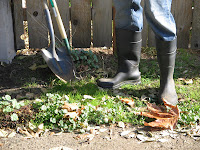 Our plan is to sheet mulch our entire front and backyard. We want to eliminate all of the grass in our yard and replace it with fruit bearing trees/shrubs and beneficial insect attracting plants. Here is a quick recap of why we don’t want grass:
Our plan is to sheet mulch our entire front and backyard. We want to eliminate all of the grass in our yard and replace it with fruit bearing trees/shrubs and beneficial insect attracting plants. Here is a quick recap of why we don’t want grass:
- Labor intensive – I want to spend my weekend leisure time putzing around the in garden, not mowing my lawn and pulling weeds.
- Expensive – lawn equipment (mowers, fuel, edgers, etc), fertilizers, etc.
- Drain of resources – constant watering, waste of my precious compost, waste of my precious time.
There is no benefit in our household to having grass because the time and money needed to maintain a pristine lawn is just not worth it to us. We would much rather have a garden filled with birds, bees, fruit, and flowers than a green lawn. Here is a quick recap of why we are choosing to sheet mulch:
- Natural method of killing grass by blocking from sunlight
- Suppresses future weed growth
- Grass and weeds are composted in place, beneath thick layers of mulch
- Improves nutrient and water retention in the soil
- Encourages soil microbial activity and worms, resulting in nutrient-rich, airy soil
- Improves plant vigor and health, often leading to improved resistance to pests and diseases
- Reusing natural materials that would otherwise go to a landfill
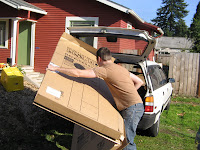 Our sheet mulching process begins with laying down huge sheets of cardboard and spraying them down with water. This draws the worms underneath up to the cardboard, which they will spend the next few months munching on. The cardboard will essentially kill the grass by blocking sunlight for a long period of time and compost in place. You can use newspaper in place of the cardboard, but it is much more satisfying to lay down a few huge sheets of refrigerator boxes then multiple small newspaper sheets. We gathered our cardboard from nearby appliance stores and a Vespa shop.
Our sheet mulching process begins with laying down huge sheets of cardboard and spraying them down with water. This draws the worms underneath up to the cardboard, which they will spend the next few months munching on. The cardboard will essentially kill the grass by blocking sunlight for a long period of time and compost in place. You can use newspaper in place of the cardboard, but it is much more satisfying to lay down a few huge sheets of refrigerator boxes then multiple small newspaper sheets. We gathered our cardboard from nearby appliance stores and a Vespa shop.
We then layer different organic materials on top of the cardboard. This could include a whole host of things: straw, grass clippings, compost, wood chips, leaves, manure, etc. It only took a couple calls before we found a local arborist who was thrilled to dump off truck loads of wood chips for free – they normally have to pay to dump this material. We just asked him to not dump any diseased or walnut tree chips, which he was happy to agree to.
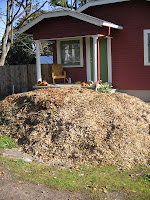 The city of Portland has several leaf drop-off points around town. Residents pay a small fee to get rid of their fluffy bags of fallen leaves. We called the city and they mail you a postcard that you return with your address and requested leaf load amount. They drop will drop off as many loads of leaves as you want – also for free. We are expecting about 3 loads to arrive over the next couple weeks. This should add some good diversity to our mulch materials. We plan to alternate layers between the leaves and more wood chips.
The city of Portland has several leaf drop-off points around town. Residents pay a small fee to get rid of their fluffy bags of fallen leaves. We called the city and they mail you a postcard that you return with your address and requested leaf load amount. They drop will drop off as many loads of leaves as you want – also for free. We are expecting about 3 loads to arrive over the next couple weeks. This should add some good diversity to our mulch materials. We plan to alternate layers between the leaves and more wood chips.
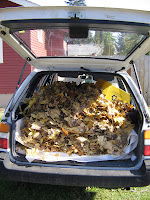 After a couple cold, autumn nights of watching the first load of wood chips quietly steam in our front yard, it was time to dig in Saturday morning. We are still waiting on the dried leaves to get dumped off, so in the mean time we made a run through East Moreland (local neighborhood with huge oak-lined streets) and loaded up on fall leaves that residents had raked into neat piles along the street. This is incident #1 of many in which we received very quizzical looks from on-lookers as we eagerly shoveled leaves into the back of our car. This was to become an on-going trend.
After a couple cold, autumn nights of watching the first load of wood chips quietly steam in our front yard, it was time to dig in Saturday morning. We are still waiting on the dried leaves to get dumped off, so in the mean time we made a run through East Moreland (local neighborhood with huge oak-lined streets) and loaded up on fall leaves that residents had raked into neat piles along the street. This is incident #1 of many in which we received very quizzical looks from on-lookers as we eagerly shoveled leaves into the back of our car. This was to become an on-going trend.
My sister and nephew came over with work gloves and tools and we all set in. The cardboard was laid into place and my nephew was in charge of watering it down.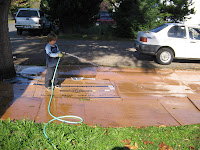 All the while, our neighbors driving by would slow down to almost a complete stop in utter confusion over why we are putting cardboard over our lawn, apparently on purpose. With the cardboard in place, we transitioned to unloading our carload of leaves and began shoveling the wood chips over one wheel barrow at a time.
All the while, our neighbors driving by would slow down to almost a complete stop in utter confusion over why we are putting cardboard over our lawn, apparently on purpose. With the cardboard in place, we transitioned to unloading our carload of leaves and began shoveling the wood chips over one wheel barrow at a time.
Around this time, the neighbors started coming out of the wood work to investigate our project. Try explaining permaculture to people who don’t even really understand the concept of reduce, reuse, recycle… The idea that soil is a living thing, the benefits of mulch, why we want birds in our yard, why we want to eat food from our yard… These are all pretty heavy concepts for them. There was a lot of half-nodding with quizzical brows going on.
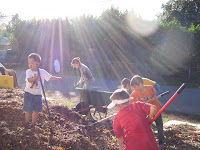 Remember the neighbor kids who threw trash on our yard a couple months ago? They also began to show up with curiosity overflowing, asking to help!?!? I quickly assessed the situation and determined there was really no harm to be done, so we told them to grab some tools and dig in. It began to feel like that show “Kid Nation”, where the kids run a small kid-only town. We had six of them shoveling and raking away. Part of me was worried we were violating some child-labor laws, but no money exchanged hands so we are probably in the clear.
Remember the neighbor kids who threw trash on our yard a couple months ago? They also began to show up with curiosity overflowing, asking to help!?!? I quickly assessed the situation and determined there was really no harm to be done, so we told them to grab some tools and dig in. It began to feel like that show “Kid Nation”, where the kids run a small kid-only town. We had six of them shoveling and raking away. Part of me was worried we were violating some child-labor laws, but no money exchanged hands so we are probably in the clear.
Those kids worked their butts off! I would say about 2 solid hours they worked away like little bees. We brought them out lots of water and sent them home with hands full of leftover Halloween candy. A fair trade I guess? They must have all slept like rocks after all their hard work. The weird thing is that I think they all had a blast helping out?
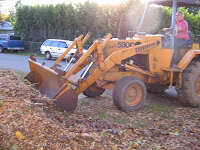 As the sun was creeping down, our wonderful neighbor Serge came home and decided to fire up this huge forklift he had sitting in his backyard. It was pretty much all over after about 10 minutes. And I walked away from all this thinking, “maybe we have a great neighborhood after all?”
As the sun was creeping down, our wonderful neighbor Serge came home and decided to fire up this huge forklift he had sitting in his backyard. It was pretty much all over after about 10 minutes. And I walked away from all this thinking, “maybe we have a great neighborhood after all?”
Sure, they don’t get the urban chicken or permaculture thing. Sure, their kids littered in our yard. But it’s really just because they don’t understand it all – they don’t understand why you shouldn’t throw trash on the street. Once I scolded the kids about littering, we’ve never had another problem with it. Even though they didn’t get the no-lawn thing, they still hung around to learn about what we were doing. And I am hopeful that in the Spring we will teach them all a little bit more when they see berry bushes, fruit trees, and flowers go into our yard. Perhaps there is hope yet…
By the end of the day we had run through our mulch materials and cardboard. We are expecting about 2-3 more days of sheet mulching as we get new loads of wood chips and dried leaves. The front yard is almost fully covered, so it’s time to start working our way back. I am hoping in about 2 weeks the project should be complete. We will quietly watch the materials break down over the next couple months. Come Spring, new plantings go in and the food forest expands!
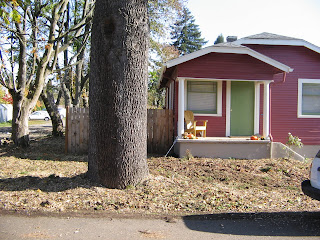
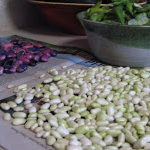

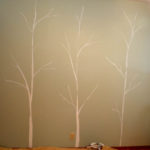
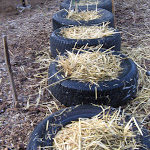

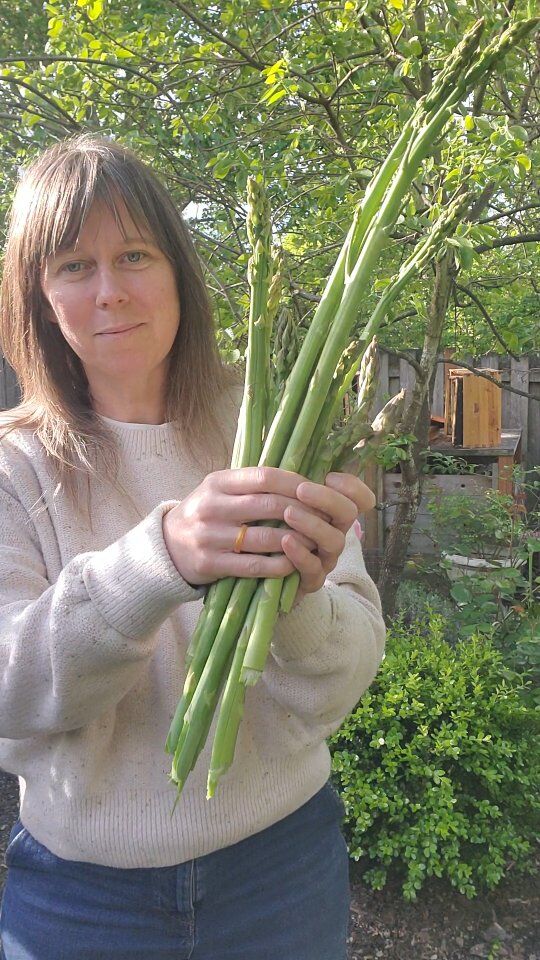
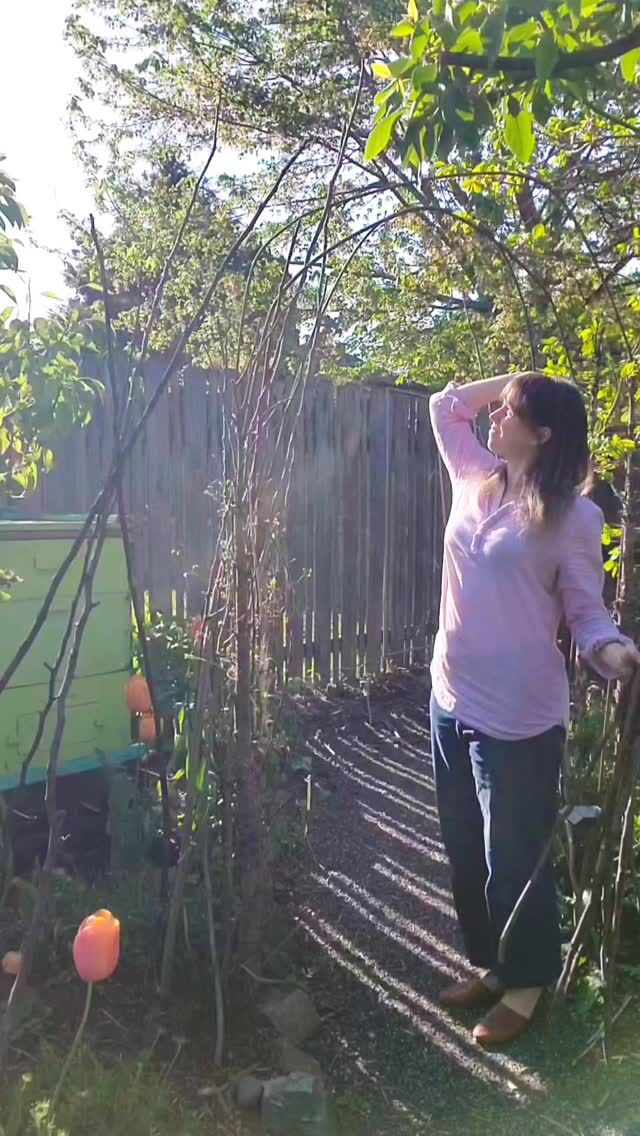
 I start with a
I start with a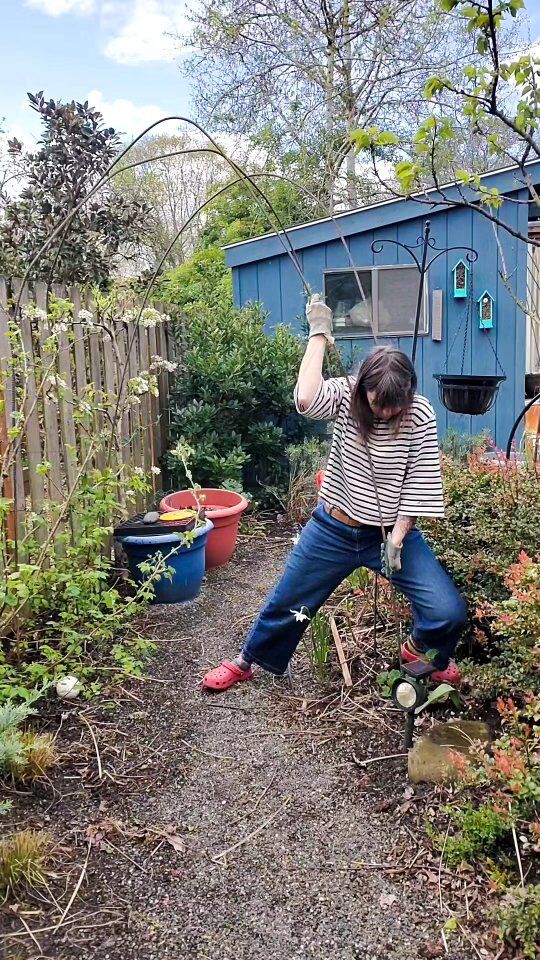
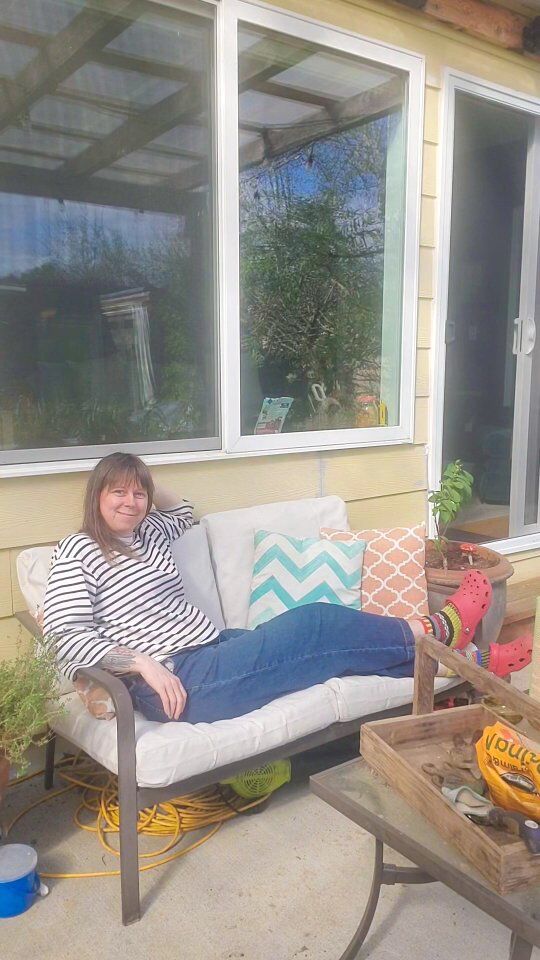
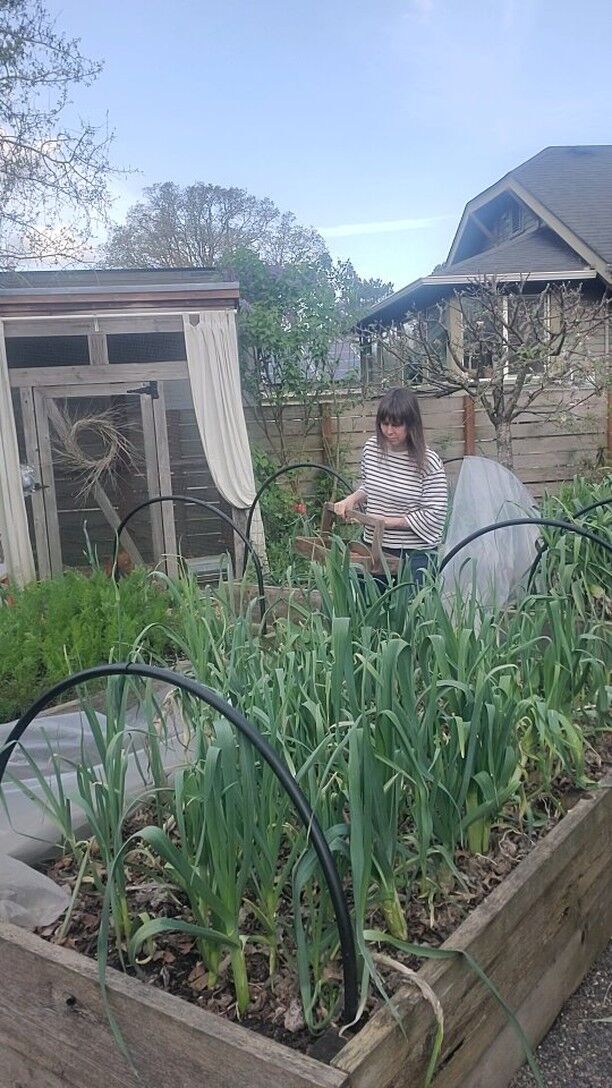
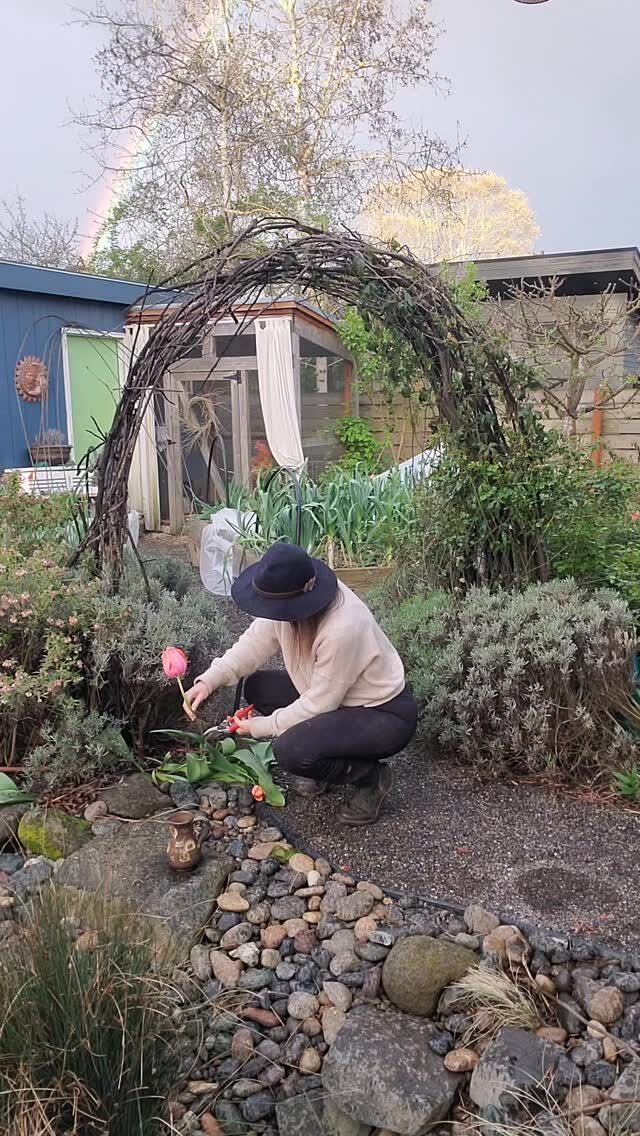
 There's a go
There's a go
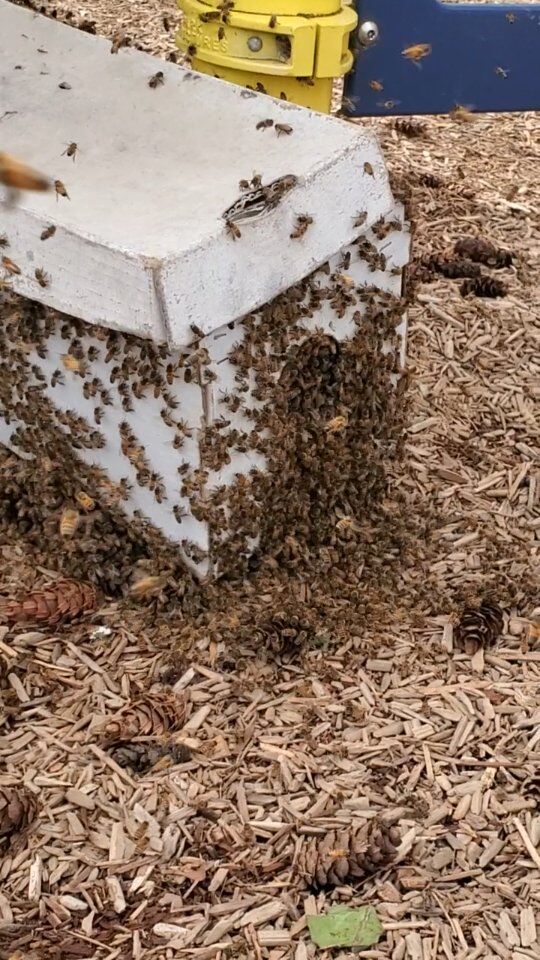
That picture of the kids in the sunbeams is so beautiful. It looks like a great time. Do you wonder whether they’re going to “share” in the harvest?
I am designing the front yard knowing that the kids, and possibly some adults, will probably eat everything that fruits. It will sort of be an unofficial community garden
When we first moved into our house, we sheet mulched the whole back yard. It worked beautifully. I look forward to seeing how this progresses for you.
This is such a cool project! I’m eager to see the final product.
Looks awesome, im very jealous of the free delivered leaves and woodchips
Its funny every time I have a major job to do the neighbourhood kids turn up and shift mulch, spread horse manure etc, my neighbours now come over every afternoon to feed the chickens and ask if there is anything they can do to help
Anyway great luck with the project it looks really cool.
I love hearing how your relationship with the neighbor kids may be transforming. I think gardening has a way of doing that to people: I love it.
We did this same thing when first beginning our garden, and we have really excellent soil now. We feel it constantly, but as you know, that’s the key.
Great documentation of your project!
Hello,
I LOVE your Blog title/heading.
I am new to this concept of sheet mulching. We are trying it out for the 1st time and I have ???
1) how thick does your final top layer of mulch/soil/good earth need to be? we have about 6-8″ of workable good soil. seems too little :l to me, not sure since I am a novice
2)we laid cardboard down in our tiers (approx 25’L x 4’W) and then we just put mixture of good top soil with rotted manure on top. Is this enough? will this work and will worms make their way to our good soil? I have no access to weed free clippings since our front lawn is weed infested right now. Possible can find hay bales to scatter, no leaves atthis time of the year, no homemade compost-can buy some.
Feelinglike we are not doingit right and we are putting somuch energy and time into it. HELP!
BTW, totally digging your idea of doing away with the lawn. Not sure it would fly in our suburban neighborhood.
I would totally appreciate any tips, advice you can throw my way.
Thx!!
SG
Hi Sonya-
I am no expert either It might be weird to walk on top of the top soil and manure though. It should break down fine, but your shoes might get muddy and stinky. Your thickness sounds fine, but the thicker the better – so I have heard.
It might be weird to walk on top of the top soil and manure though. It should break down fine, but your shoes might get muddy and stinky. Your thickness sounds fine, but the thicker the better – so I have heard.
I called a local tree/arbor guy and asked if he could drop off loads of wood chips (no diseased trees/no walnut). Maybe you could do the same for the top layer? It’s free, you would have a nicer surface to walk on, and it would help hold in rain during the dry months.
Hope that helps!
-Renee
Wow! That’s amazing! I hate lawns also and I’ve been having hard time trying to explain that to people. Lawn is the most laborous, most expensive and most useless part of the garden. It should always be the very last option, like, if there’s no other choice to grow anything else, let it be lawn then. But even then it should be lawn of dandelions and white clover instead of just grass… Anyways, you guys rock!
Annonymous, we share like minds. Glad you enjoy reading about the project!